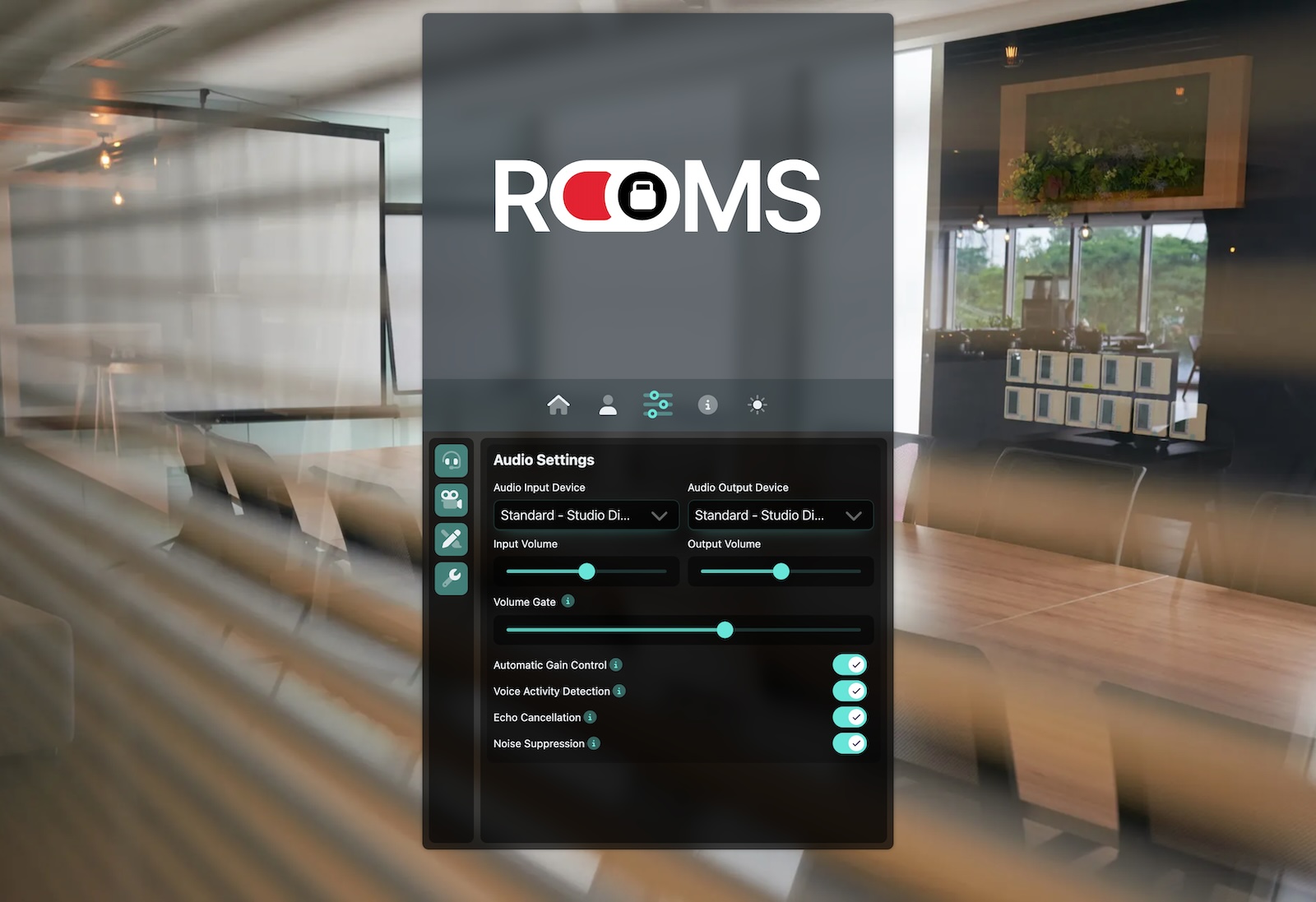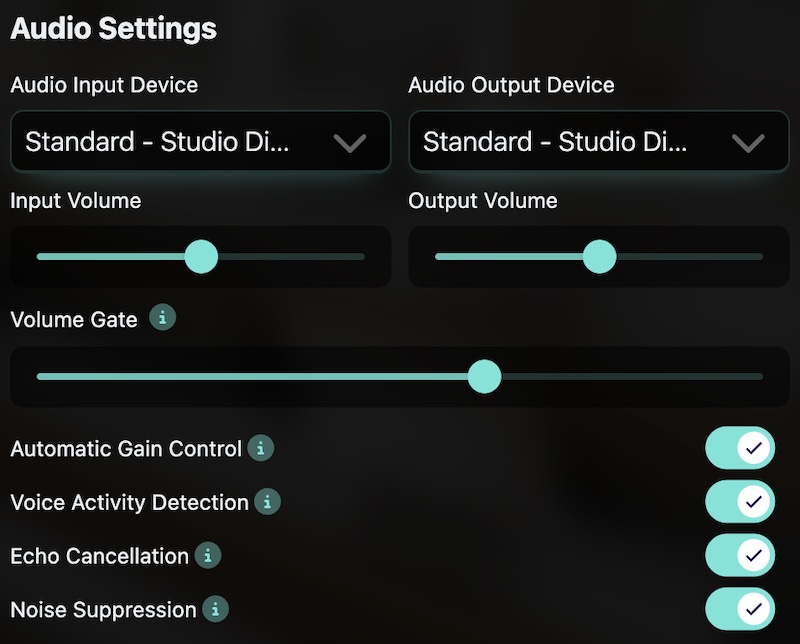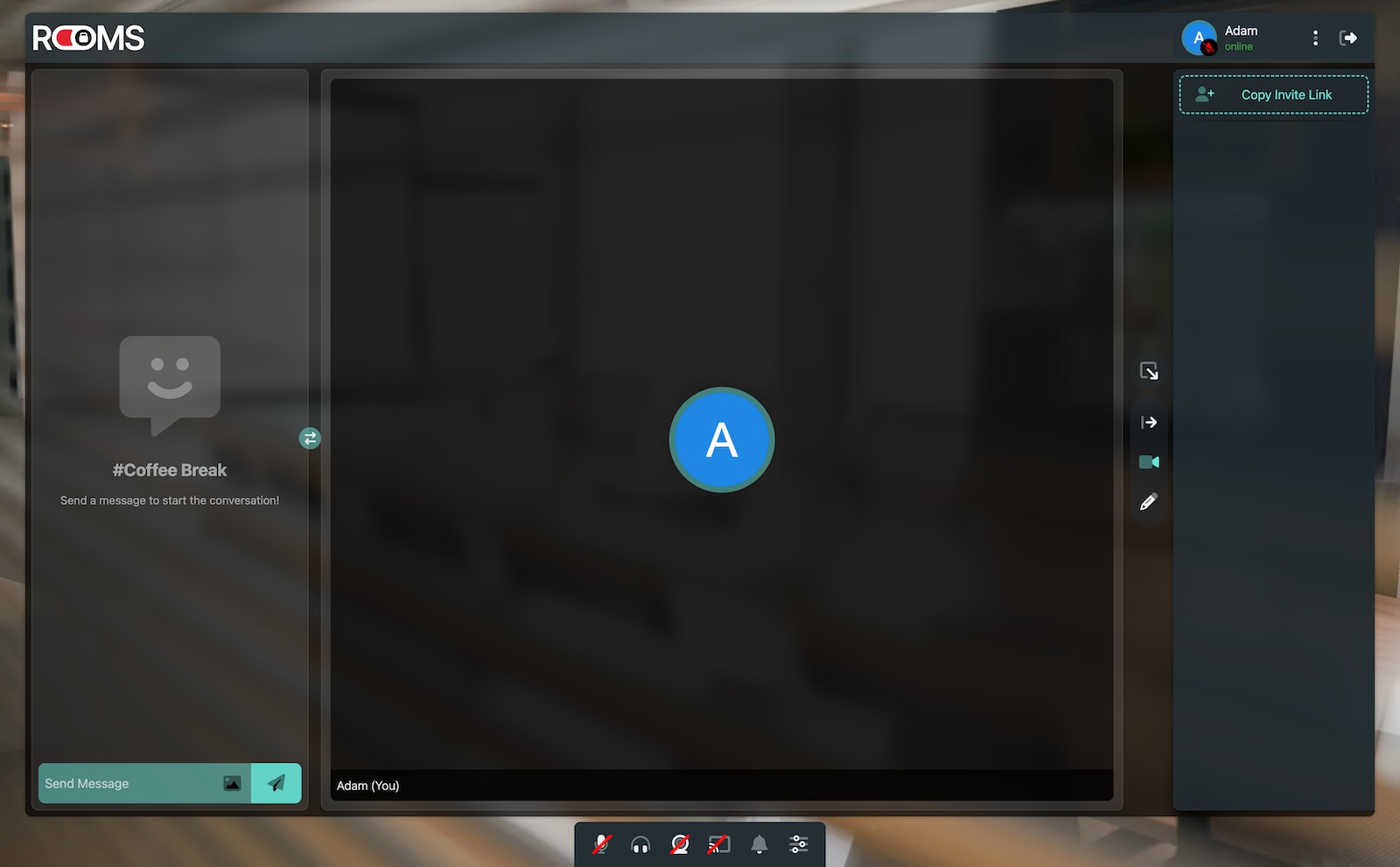Your First Call
In this guide, we'll assume that you have set up your own Rooms instance and that you have a basic understanding of how Rooms works. If you haven't done this yet, please follow the Getting Started Guide first.
The first time you join a room, or you open Audio and Video Settings (this applies to all your guests as well), your browser will ask for permission to access your microphone and camera. You need to allow this to use audio and video in Rooms. Not doing so will prevent you from using these features. If you accidentally denied access, you can change this in the settings of your browser.
Before we join the room, let's make sure that Audio and Video Settings are correct.
Audio and Video Settings
Before you join a room, you should check your audio and video settings. You can do this by clicking on the sliders icon above the room name input field (see screenshot below).
 Settings
Settings
On the left side of the settings dialog, you can switch between Audio and Video settings. Depending on your permissions (i.e., if you are the owner or a guest with permissions), you may see additional settings there.
Audio Settings
Let's focus on the audio settings first. You should see something like this if you have the audio tab selected:
 Audio Settings
Audio Settings
Audio Input Device:
Select the audio input device you want to use, usually your microphone. The dropdown list contains all available audio
input devices. On Windows, this might be something like "Microphone (Realtek Audio)" or "Microphone (Logitech Webcam)".
On Mac, it could be "Internal Microphone" or "Airpods ...".
Audio Output Device:
Select the audio output device you want to use, such as your speakers or headphones. The dropdown list contains all
available audio output devices. On Windows, this could be "Speakers (Realtek Audio)" or "Headphones (Logitech Webcam)".
On Mac, it might be "Internal Speakers" or "Airpods ...".
Input Volume:
Adjust the input volume of your microphone by moving the slider. This is helpful if your microphone is too loud or too
quiet.
Output Volume:
Adjust the output volume of your speakers or headphones using the slider.
Volume Gate:
Rooms tries to prevent environmental noise or low-quality microphones from being transmitted to other participants. The
volume gate sets the threshold at which the microphone activates.
Automatic Gain Control:
When enabled, Rooms will automatically adjust your microphone's volume to ensure consistent levels.
Voice Activity Detection:
If enabled, Rooms will use AI to detect when you are speaking and mute your microphone when you're not.
Echo Cancellation:
This feature helps to prevent sound from your speakers from feeding back into the microphone.
Noise Suppression:
Enable this to suppress background noise, useful in noisy environments or when using low-quality microphones.
Video Settings
The next tab contains the video settings. Here you can set up the webcam you want to use for video. You should see something like this:
 Video Settings
Video Settings
Video Device:
Select the video device you want to use, usually your webcam. On Windows, this could be "Logitech Webcam" or "Integrated
Webcam". On Mac, it might be "FaceTime HD Camera" or "Logitech Webcam".
Start Cam:
Click this button to start your selected webcam to verify that it's working correctly.
If you're using the video settings for the first time, you might only see a "Start Cam" button. Click it to initiate the camera and trigger the browser to request permission to access your camera.
Creating/Joining a Room
If you've read the Basic Concepts guide, you know that Rooms is organized by rooms. Instead of focusing on time and date like other tools, Rooms is centered around the room itself. You can create a room for specific purposes—meetings, brainstorming, gaming, or just hanging out.
When your Rooms instance is set up, opening the URL (e.g., https://talk.rooms.chat) will show something like this:
 Join Room
Join Room
In Rooms, you join a room directly. If it doesn’t exist, it will be created automatically, and you'll be the first person there. If it already exists, you’ll join and see others in the room.
Enter the name of the room you want to join or create and press the "Join Room" button. Examples of room names are
coffee-break, we-hate-to-eat-alone, lets-play-a-game, devs, marketing, or anything that comes to mind.
Room names are case sensitive and can contain any character except for /. For example, Coffee Break and
coffee break are different rooms. For private conversations, use a name that’s hard to guess, like FE12-GH23-AB45.
For this guide, I’ve chosen Coffee Break. After joining the room, you will see the Rooms user interface.
 Rooms UI after joining an empty room
Rooms UI after joining an empty room
Inviting Others
Once in the room, you can invite others by sharing the room name or a link to the room. Click on the **Copy Invite Link
** button to copy the link, which will follow this format: https://{subdomain}.rooms.chat/{room-name}. For example, if
your instance is talk.rooms.chat and your room is coffee-break, the link would be
https://talk.rooms.chat/coffee-break.
You can share this link via any method, and participants can join by simply opening the link in their browser.
Users don’t need an account or software to use ODIN Rooms—just open the URL in a browser and join the room.
Next Steps
That's it! You've successfully joined your first room in Rooms. You can now use it for chatting, brainstorming, meetings, or just hanging out.
Rooms offers more features like a whiteboard, chat, and screen sharing. Navigate to our manual to learn more about Rooms features.